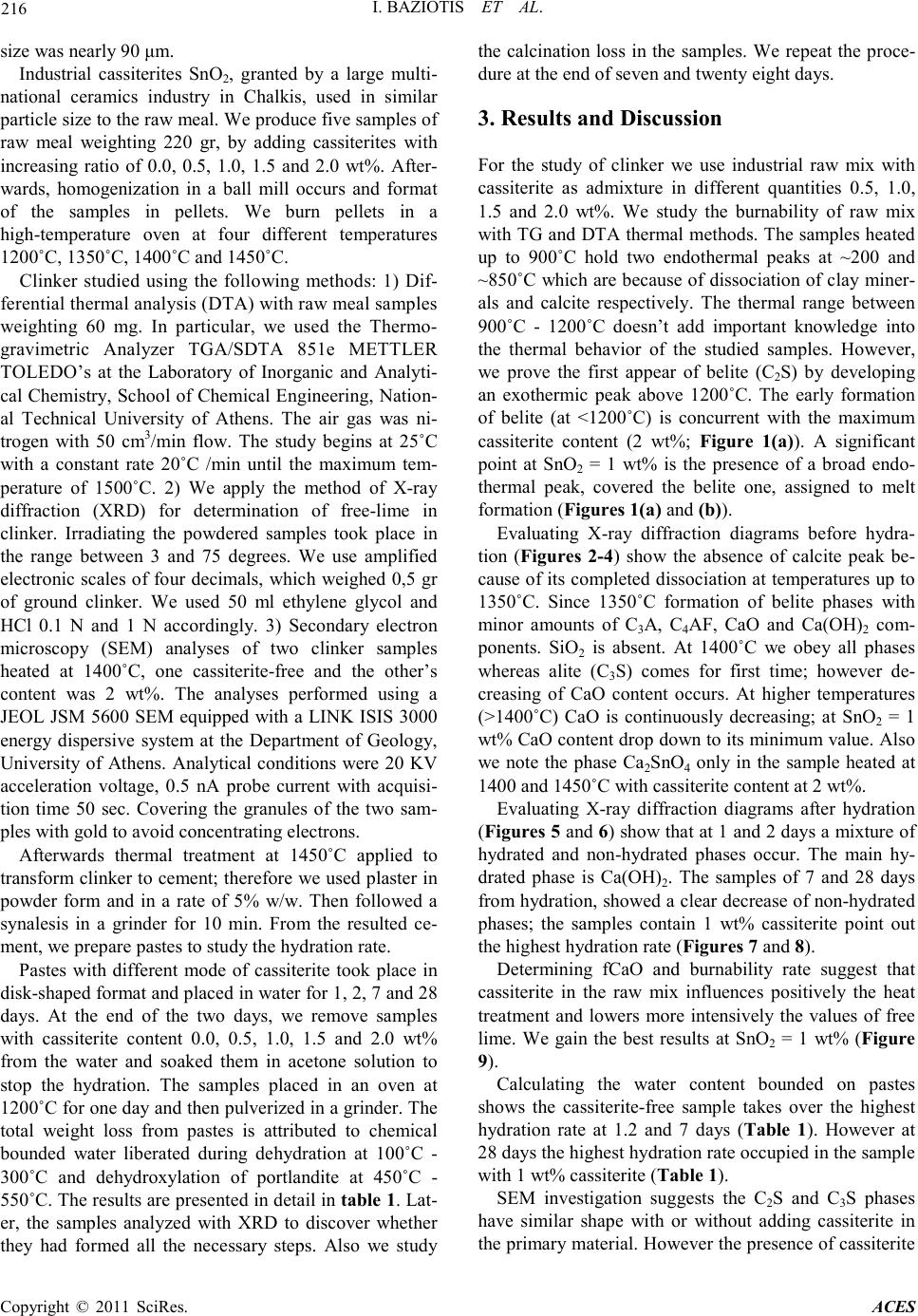
I. BAZIOTIS ET AL.
Copyright © 2011 SciRes. ACES
size was nearly 90 μm.
Industrial cassiterites SnO2, granted by a large multi-
national ceramics industry in Chalkis, used in similar
particle size to the raw meal. We produce five sample s o f
raw meal weighting 220 gr, by adding cassiterites with
increasing ratio of 0.0, 0.5, 1.0, 1.5 and 2.0 wt%. After-
wards, homogenization in a ball mill occurs and format
of the samples in pellets. We burn pellets in a
high-temperature oven at four different temperatures
1200˚C, 1350˚C, 1400˚C and 1450 ˚C.
Clinker studied using the following methods: 1) Dif-
ferential thermal analysis (DTA) with raw meal samples
weighting 60 mg. In particular, we used the Thermo-
gravimetric Analyzer TGA/SDTA 851e METTLER
TOLEDO’s at the Laboratory of Inorganic and Analyti-
cal Chemistry, Schoo l of Che mical En gineeri ng, Nation-
al Technical University of Athens. The air gas was ni-
trogen with 50 cm3/min flow. The study begins at 25˚C
with a constant rate 20˚C /min until the maximum tem-
perature of 1500˚C. 2) We apply the method of X-ray
diffraction (XRD) for determination of free-lime in
clinker. Irradiating the powdered samples took place in
the range between 3 and 75 degrees. We use amplified
electronic scales of four decimals, which weighed 0,5 gr
of ground clinker. We used 50 ml ethylene glycol and
HCl 0.1 N and 1 N accordingly. 3) Secondary electron
microscopy (SEM) analyses of two clinker samples
heated at 1400˚C, one cassiterite-free and the other’s
content was 2 wt%. The analyses performed using a
JEOL JSM 5600 SEM equipped with a LINK ISIS 3000
energy dispersive system at the Department of Geology,
Universit y of Athens. Analytical conditions were 20 KV
acceleration voltage, 0.5 nA probe current with acquisi-
tion time 50 sec. Covering the granules of the two sam-
ples with gold to avoid concentrating electrons.
Afterwards thermal treatment at 1450˚C applied to
transform clinker to cement; therefore we used plaster in
powder form and in a rate of 5% w/w. Then followed a
synalesis in a grinder for 10 min. From the resulted ce-
ment, we prepare pastes to study the hydration rate.
Pastes with different mode of cassiterite took place in
disk-shaped format and placed in water for 1, 2, 7 and 28
days. At the end of the two days, we remove samples
with cassiterite content 0.0, 0.5, 1.0, 1.5 and 2.0 wt%
from the water and soaked them in acetone solution to
stop the hydration. The samples placed in an oven at
1200˚C for one da y and then pulve riz ed i n a grind er. The
total weight loss from pastes is attributed to chemical
bounded water liberated during dehydration at 100˚C -
300˚C and dehydroxylation of portlandite at 450˚C -
550˚C. The results are presented in detail in table 1. Lat-
er, the samples analyzed with XRD to discover whether
they had formed all the necessary steps. Also we study
the calcination loss in the samples. We repeat the proce-
dure at the end of seven and twe nty ei ght d ays.
3. Results and Discussion
For the study of clinker we use industrial raw mix with
cassiterite as admixture in different quantities 0.5, 1.0,
1.5 and 2.0 wt%. We study the burnability of raw mix
with TG and DTA thermal methods. The samples heated
up to 900˚C hold two endothermal peaks at ~200 and
~850˚C which are because of dissociation of cla y miner-
als and calcite respectively. The thermal range between
900˚C - 1200˚C doesn’t add important knowledge into
the thermal behavior of the studied samples. However,
we prove the first app ear of belite (C2S) by developing
an exothermic peak above 1200˚C. The early formation
of belite (at <1200˚C) is concurrent with the maximum
cassiterite content (2 wt%; Figure 1(a)). A significant
point at SnO2 = 1 wt% is the presence of a broad endo-
thermal peak, covered the belite one, assigned to melt
formation (F igures 1(a) and (b)).
Evaluating X-ray diffraction diagrams before hydra-
tion (Figures 2-4) show the absence of calcite peak be-
cause of its completed dissociation at te mperat ures up to
1350˚C. Since 1350˚C formation of belite phases with
minor amounts of C3A, C4AF, CaO and Ca(OH)2 com-
ponents. SiO2 is absent. At 1400˚C we obey all phases
whereas alite (C3S) comes for first time; however de-
creasing of CaO content occurs. At higher temperatures
(>1400˚C) CaO is continuously decreasing; at SnO2 = 1
wt% CaO content drop down to its minimum value. Also
we note the phase Ca2SnO4 only in the sample heated at
1400 and 1450˚C with cassiterite content at 2 wt%.
Evaluating X-ray diffraction diagrams after hydration
(Figures 5 and 6) sho w that a t 1 and 2 days a mixture o f
hydrated and non-hydrated phases occur. The ma i n hy-
drated phase is Ca(OH)2. The samples of 7 and 28 days
from hydration, showed a clear decrease of non-hydrated
phases; the samples contain 1 wt% cassiterite point out
the highest h ydration rate (Figure s 7 and 8).
Determining fCaO and burnability rate suggest that
cassiterite in the raw mix influences positively the heat
treatment and lowers more intensively the values of free
lime. We gain the best results at SnO2 = 1 wt% (Figure
9).
Calculating the water content bounded on pastes
shows the cassiterite-free sample takes over the highest
hydration rate at 1.2 and 7 days (Table 1). However at
28 days the highest hydration rate occupied in the sample
with 1 wt% cassiter ite (Table 1).
SEM investigation suggests the C2S and C3S phases
have similar shape with or without adding cassiterite in
the primary material. However the presence of cassiterite